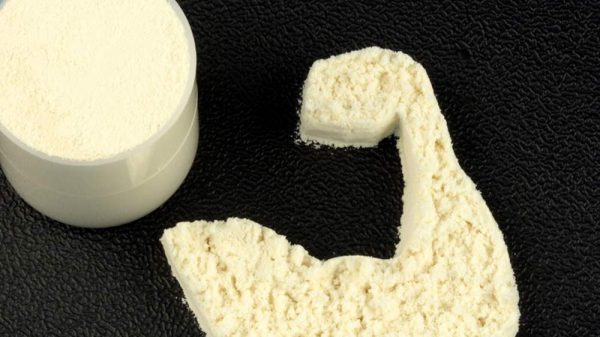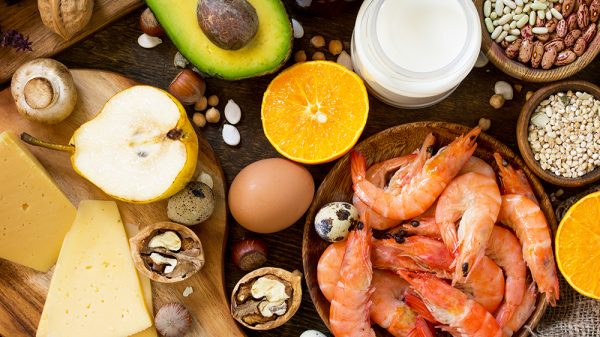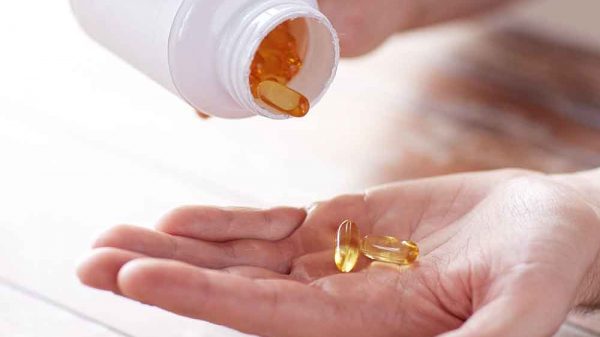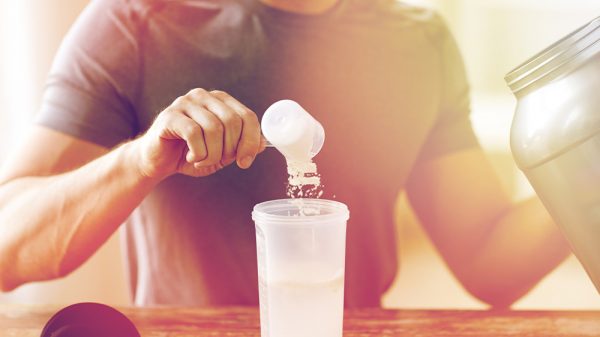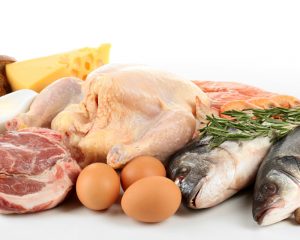As a kid, you may remember your parents telling you to clear your plate, which likely contained protein, as well as fats and carbohydrates. You may remember learning about the food pyramid in school, with proteins taking up the third tier. But why is it so important to incorporate protein into your diet? What are the functions of proteins in the body? Here we answer all of your questions about why protein is an indispensable part of your diet and how it supports healthy biological functioning.
What Is Protein, Anyway?
Let’s take an up-close look at what proteins are, on a molecular level. To understand the role of protein in the body, it’s first crucial to answer the question, what are the building blocks of protein? Proteins are made of individual components called amino acids.
Amino acids are nitrogenous compounds that all share a carboxyl group and an amino group that are chemically identical. All amino acids also contain an R group, which is also referred to as a side chain. Each R group is different and helps determine the specific function of proteins. Amino acids are distinguished by the chemical makeup of their R groups. Depending on an R ground composition, amino acids will exhibit certain properties, such as being hydrophilic or hydrophobic. The term hydrophilic means that a compound exhibits polar properties and is attracted to water molecules, while a hydrophobic compound repels water molecules. Certain characteristics such as these impact the way that amino acids interact with each other, which influences the type of protein produced from the amino acids.
Protein Structure Levels
Individual amino acids bind together in specific ways to create certain shapes that fit a protein’s function. The first level of protein structure is called the primary structure. Amino acids connect to each other through peptide bonds. When amino acids are strung together, they first create long strands of amino acids called polypeptide chains. The sequence of amino acids in a polypeptide is a determining factor for the secondary and tertiary structures that will form.
These polypeptides then further interact to form a secondary structure, which is created by the orientation and interaction of polypeptides to form beta sheets or the interaction of alpha-helices. The next protein structure level is called the tertiary structure, which is created by the folding of the secondary structure. The tertiary structure is usually described as a three-dimensional protein shape that fits the protein’s function. Finally, the last protein structure level is the quaternary structure, which is made up of several subunits, which allows the protein to reach its final form.
What Happens When We Eat Protein?
For the amino acids in protein to become completely accessible, dietary protein must go through the digestive system. When we take a bite of food, we grind up protein through a process called mechanical digestion. These ground-up protein particles then enter the stomach and intestine, where proteolytic enzymes break the peptide bonds between amino acids. Individual amino acids are then absorbed through the intestinal wall and enter the bloodstream, where they are carried throughout the body.
Types of Amino Acids: Essential vs Nonessential
There are two major groups of amino acids when it comes to the relevance of amino acids in human health.
Essential amino acids are those that are nutritionally indispensable for optimal biological functioning. The body cannot synthesize essential amino acids, and it is therefore required that we obtain them from the foods we eat. There are nine essential amino acids: leucine, isoleucine, valine, phenylalanine, tryptophan, histidine, threonine, lysine, and methionine. Getting optimal ratios of essential amino acids on a daily basis is critical for the human body to function as well as possible.
In contrast, nonessential amino acids can be produced internally by the body, which means that it is not necessary to get certain amounts through your diet on a daily basis.
There is a third category of amino acids that are described as conditionally essential. This means that under certain circumstances, the body may require more of these amino acids than it can produce. In particular, the body utilizes and requires more amino acids during periods of stress, injury, and illness.
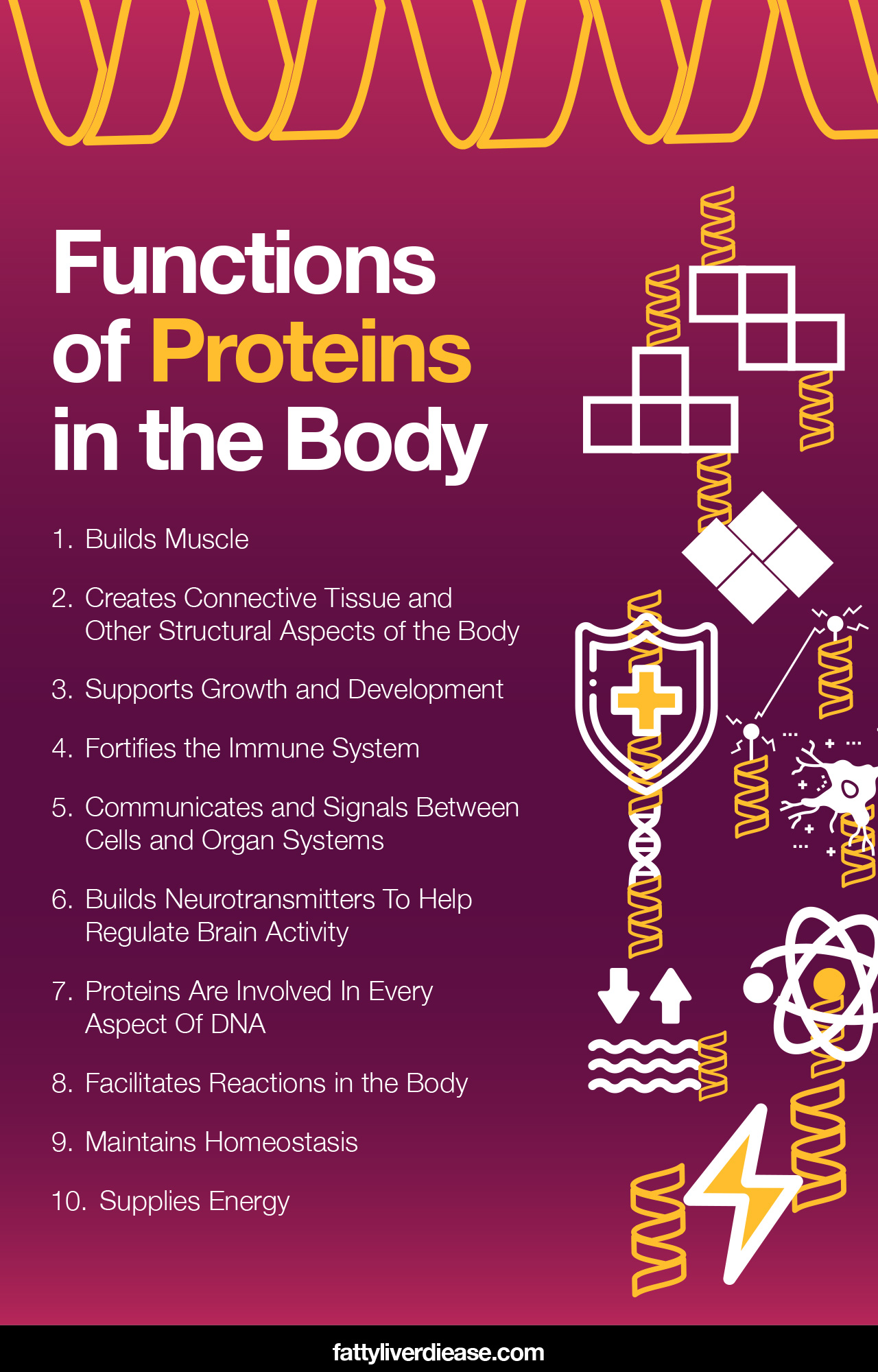
How Does Protein Function in the Body?
What is the function of proteins? Proteins are absolutely critical for the healthy functioning of every part and every organ system in the body. Different proteins have different functions. We’ve put together a list of all of the critical functions of the protein.
1. Building Muscle
Building muscle is one of the critical functions of protein in the body. Amino acids are the fundamental building blocks of muscle tissue. As we work out and engage in strength training, muscle fibers are torn and must be repaired during recovery using the amino acids we get from food.
Aside from working out and building muscle, protein and amino acids are also critical for simply maintaining muscle mass. On a daily basis, the amino acids that comprise muscle tissue turn over, and amino acids no longer needed are filtered out and excreted from the body. The body must then replace these amino acids with fresh amino acids from the food we eat. Eating adequate amounts of protein is important at all ages. However, it’s especially important for older adults to consume adequate amounts of protein since this age group tends to be more prone to muscle wasting and sarcopenia.
2. Creating Connective Tissue and Other Structural Aspects of the Body
Amino acids are crucial for synthesizing collagen that is found in connective tissues like tendons and ligaments. Connective tissues are responsible for helping the body maintain structure and shape, and are also responsible for protecting internal organs and supporting joints. Structural proteins help the cells and tissues throughout the body maintain their shape and integrity.
Keratin is another type of protein that plays a role in creating structural parts of the body. Keratin is a fibrous protein since it is responsible for making up the tough, structural parts of the body. For example, hair and nails are made of keratin.
3. Supporting Growth and Development
Amino acids from protein are critical for supporting growth and development for children and adolescents. In fact, children and adolescents’ amino acid requirements are sometimes significantly higher than that for adults, simply because children and adolescents are rapidly growing and developing and utilizing building blocks like amino acids at a much higher rate. It’s important for youth to consume an abundance of protein that offers amino acids and optimal ratios to facilitate healthy growth and development of skin, connective tissue, and muscle.
4. Fortifying the Immune System
What is the role of the immune system? In a nutshell, the immune system is responsible for keeping us healthy. For example, when viruses, bacteria, or parasites invade the body, the immune system is responsible for detecting the infection and launching a defensive attack that wards off foreign invaders. Additionally, the immune system is responsible for detecting cancerous cells that develop in the body and facilitating apoptosis (cell death) for these cells.
So, how is a protein involved in the immune system? Protein plays a critical role in forming antibodies, which are the immune system compounds that launch attacks against foreign invaders. Also called immunoglobulins, antibodies are tailored to attack different infectious agents.
Without protein, we wouldn’t have antibodies, and we wouldn’t be able to keep the body safe by launching attacks against viruses and bacteria.
5. Communicating and Signaling Between Cells and Organ Systems
For organ systems to function properly, there must be communication between all participating cells and tissues. On top of that, all of the organ systems throughout the body do not operate in isolation. They must all communicate with one another to make sure that all processes stay in balance. Proteins are responsible for communicating and signaling between different parts of the body. These communication proteins are called hormones.
Insulin is one excellent example of a signaling protein that communicates critical messages between cells and organ systems. When we eat a carbohydrate-rich meal, the body breaks down carbs into glucose molecules, which are then released into the bloodstream to spike blood sugar. In response to the presence of glucose in the bloodstream, the pancreas releases insulin to inform all of the body’s cells to uptake glucose from the bloodstream and use it as energy. Without insulin signaling to the cells that sugar is present, the cells wouldn’t know when to utilize sugar from the bloodstream.
Epinephrine and norepinephrine are two other hormones that are responsible for communicating with other parts of the body. Epinephrine and norepinephrine are released from adrenal glands in reaction to sympathetic nervous system activation. The sympathetic nervous system is triggered when we experience something frightening or startling. The sympathetic nervous system response is an automatic response that releases a flood of epinephrine and norepinephrine. When these hormones are released, they trigger several physiological reactions that heighten our attention and pause biological processes that are not essential for survival. For example, the mouth gets dry, digestion is paused, the heart rate increases, and the skin begins to sweat. The body and mind have entered a state of hyperawareness known as the “fight-or-flight” response that helps us survive when faced with circumstances that threaten wellbeing and safety.
6. Neurotransmitters
Amino acids in protein are also important for building neurotransmitters that help regulate brain activity. In a way, neurotransmitters are like communicators for the brain and nervous system. For example, neurotransmitters derived from protein include serotonin, dopamine, and gamma-aminobutyric acid (GABA).
Serotonin is a neurotransmitter responsible for regulating mood and sleep cycles. Dopamine is a neurotransmitter involved in the reward circuit. Certain activities that we find fun – such as eating – are known to trigger dopamine release. GABA neurotransmitters are responsible for controlling the levels of excitement across other neurotransmitters. In a way, GABA can be considered a regulatory neurotransmitter.
7. Reading DNA
Deoxyribose nucleic acid- also known as DNA – is an individual blueprint that is completely unique to each person. But what exactly is DNA? In molecular biology terms, DNA is a double helix made of a sugar-phosphate backbone and chemical bases in the interior. These chemical bases are adenine, guanine, thymine, and cytosine. The order of these bases in the DNA strand is what defines each person’s unique genetic code.
So what is contained within each person’s unique genetic code? Interestingly, the order of the DNA bases signifies the amino acid sequence for all the proteins in the body. While many of the proteins in every human body are identical, the variations in functions and characteristics of other proteins ultimately make each person different.
On top of that, proteins are required to actually decipher DNA. Proteins called polymerases are responsible for reading a DNA strand and converting it into messenger RNA. The information from this strand of RNA is then used to produce specific sequences of amino acids for proteins. In particular, ribosomes are the parts of each cell responsible for converting the information from RNA into the appropriate proteins.
Proteins are involved in every aspect of DNA and define who we are as individuals!
8. Facilitating Reactions in the Body
Proteins are responsible for making sure that necessary biochemical reactions in the body actually occur. These kinds of proteins are called enzymes. Enzymes are proteins that catalyze biochemical reactions. Different enzymes are designed to help facilitate specific types of biochemical reactions.
Enzymes are critical for every organ system and bodily function, including energy production, muscle contraction, and the breakdown of food particles.
The digestive system is one area of the body that contains numerous enzymes that help carry out different digestive processes that help break down food. Here are a few examples:
- Lipase: Lipase enzymes facilitate biochemical reactions that break down fat into more manageable structures, like fatty acids. An example of lipase includes pancreatic lipase, which is released by the pancreas following a high-fat meal.
- Protease: As the name might suggest, protease is responsible for breaking down dietary proteins into individual amino acids. Stomach cells produce pepsin, which is a protease that helps facilitate the digestion of protein.
- Amylase: This protein is responsible for breaking the bonds between molecules in a carbohydrate source to produce sugar.
9. Maintaining Homeostasis
Maintaining homeostasis in the body essentially means maintaining balance in terms of fluid levels, pH, and temperature. Fluid levels refer to the amount of water contained within cells and within the extracellular fluid. The pH measure signifies the acidity of bodily fluids, while body temperature indicates the body’s heat levels, which averages at about 98.6 degrees Fahrenheit. If any of these parts of the body are imbalanced, this can cause unfavorable circumstances in the body. For example, having a temperature that is too high or a pH that is too acidic may result in the denaturation of proteins, which means that the proteins lose their shape and become unable to carry out their functions.
Proteins like albumin and globulin play a critical role in making sure that the cells and extracellular spaces between cells contain the proper level of fluid. However, if you eat insufficient levels of protein and amino acids, the body begins to lose the ability to regulate fluid levels. As a result, the extracellular space becomes swollen with fluid, leading to water retention and edema, which jeopardizes health and wellbeing.
Other proteins, such as hemoglobin, play a role in stabilizing the body’s pH. Hemoglobin, in addition to binding oxygen in the bloodstream, is also responsible for binding acidic particles, which helps maintain a stable pH.
Proteins also serve as gatekeepers of every cell, helping maintain the balance of certain compounds inside and outside the cell. For example, the sodium-potassium pump is one of these transport proteins that is situated in all of the cell membranes throughout the body. Specifically, the sodium-potassium pump is a protein called an ATPase that helps ensure that the appropriate amount of sodium and potassium is contained within the cell at all times.
10. Supplying Energy
Though this may seem intuitive, it’s important to mention that protein in the diet is also a significant source of calories. When proteins are broken down into smaller pieces, they also supply energy in the form of calories, which the body can harness to power reactions throughout the body. For each gram of protein that you consume, the body is supplied with 4 calories.
Examples of Proteins to Include in Your Diet
To make sure you’re getting all of the protein you need, it’s important to know what foods count as protein.
Animal Proteins
Proteins are one major category of dietary protein. Animal proteins encompass food sources like milk, cheese, yogurt, eggs, beef, chicken, and fish. These foods are considered to be the highest quality protein Source available to humans. This is because animal proteins have a high protein digestibility corrected amino acid score, also known as a PDCAAS. This means that animal proteins contain all essential amino acids and optimal ratios for human functioning and that the essential amino acids are bioavailable for use by the human body.
Incorporating high-quality animal proteins into your diet will help with nearly all body functions, including muscle growth and immune system health. However, to make the best choices for your health, it’s best to choose animal proteins that are minimally processed and are produced on organic farms that do not use antibiotics and hormones. It’s also a good idea to choose animal products low in saturated fat since saturated fat can contribute to insulin resistance and heart disease.
Plant Proteins
Animal proteins aren’t the only protein source available. If you follow a plant-based diet due to personal preferences or dietary needs, rest assured that you can get all the protein you need from plants. However, unlike animal proteins, plant proteins generally do not have a high PDCAAS score, which means that plant-based proteins are usually missing at least one essential amino acid. As a result, when relying on plant proteins for all essential amino acids, it’s necessary to eat various plant proteins throughout the day to meet your essential amino acid needs. Examples of plant-based proteins include nuts, seeds, beans, whole grains, soybeans, tofu, and tempeh.
Alternatively, especially if you are following a vegan diet or require lots of essential amino acids, supplementing helps make sure your body has all of the raw materials that it needs to carry out all necessary processes. Just make sure that you choose a high-quality supplement that contains optimal ratios of essential amino acids to support your health.
Functions of Proteins in the Body: Conclusion
Protein is one of the most important compounds in the human diet. In fact, protein may even be the most important nutrient in the human diet because of amino acids’ role in nearly all biological processes. Moreover, protein is also crucial for deciphering DNA, producing enzymes, synthesizing muscle tissue, and carrying out numerous mechanisms throughout the body. The two major categories of amino acids are essential amino acids and nonessential amino acids. While essential amino acids are nutritionally indispensable, nonessential amino acids can be synthesized internally to meet biological needs.
